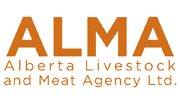Fine tuning fecal starch can cut your feed bill
| Project Code: | 2014C335F |
| Completed: | 2015 |
Project Title:
Researchers:
Kim Stanford, PhD; Mary-Lou Swift, PhD kim.stanford@gov.ab.ca
Kim Stanford, PhD (Alberta Agriculture and Forestry) Mary-Lou Swift, PhD (Hi-Pro Feeds) Tim McAllister, PhD (Agriculture and Agri-Food Canada) Darryl Gibb, PhD (Gowans Feed Consulting)
Feces produced by feedlot cattle offer a window into overall efficiency of nutrient digestion and although many insights can be gained by fecal analyses, knowing fecal starch and fecal nitrogen is of particular value. Fecal starch values higher than 13% generally indicate a need to change grain processing practices as feed costs increase in direct proportion to the percentage of grain not being digested by the cattle. Fecal nitrogen is valuable as it improves prediction of fecal starch. It would be expected that the feedlot industry would routinely monitor these factors, but determining fecal starch and fecal nitrogen by traditional wet chemistry requires approximately 3 days in a specialized laboratory and is expensive ($40/sample). For the beef industry to maximize production advantages from knowledge of fecal starch and fecal nitrogen, more rapid and inexpensive on-farm methods for these analyses are needed.
Near Infrared Reflectance Spectroscopy (NIRS) has previously been used to analyze feces of dairy cattle, primarily in grazing situations to monitor feed and forage intake, quality and digestibility. Previous work by our laboratory has shown that NIRS technology was able to indirectly predict the feed conversion efficiency of feedlot cattle by predicting fecal starch. However, our previous study evaluated feces after drying in a forced air oven and grinding as previous studies where “fresh/wet” feces were scanned by NIRS resulted in “noisy spectra”, reduced correlation coefficients and increased errors of prediction. Consequently, a method for on-farm drying of feces prior to scanning by NIRS is required. To minimize time and equipment for sample preparation, methods to dry feces which do not require subsequent grinding prior to NIRS scanning would be optimal for on-farm use. Accordingly, this project evaluated microwave drying of feces before NIRS scanning to predict fecal starch and fecal nitrogen. The relationship between these factors and growth performance of feedlot cattle was also determined.
Objectives:- Determine a practical method for drying feces that can be applied at the farm.
- Development of robust NIRS calibration models to predict nitrogen and starch contents in fecal samples processed under methods proposed under objective #2.
- Examine relationship of fecal starch and fecal nitroten with feed conversion efficiency of feedlot cattle
A preliminary study evaluated the power output of a microwave oven. Feces from feedlot cattle were collected and different durations of heating were evaluated for drying potential without causing heat damage to feces. After the optimal microwave drying time and sample size was determined, feces were collected from cattle receiving finishing diets in 15 commercial feedlots in southern Alberta. From these feedlots, fecal samples were collected from a total of 94 selected pens. Microwaved feces samples (n=94) were then scanned by NIRS and analysed for nitrogen and starch content. A subsamples of fecal samples (n=50 and 58, respectively) were used to develop NIRS calibrations for determination of fecal starch and fecal nitrogen. Close-out growth performance data was obtained from 27 pens of the cattle in 9 feedlots where feces had been collected and analysed and growth performance of the cattle was compared to starch and nitrogen content of the feces determined through traditional wet chemistry.
What They Learned:Drying 400 g feces for 15 minutes on high power increased fecal dry matter to approximately 40%, without heat damage to feces as measured by acid-detergent insoluble nitrogen or changes in fecal nitrogen content.. However, NIRS was not useful for predicting fecal starch (FS; R2=0.36, standard error of the coefficient of variation SECV=1.86) although was a better predictor of fecal nitrogen (R2=0.51, SECV=0.10). Possibly, FS is not uniformly distributed in feces as it is often contained within whole grain kernels, making grinding of feces necessary before scanning by NIRS.
Based on these results, on-farm scanning of feedlot cattle feces by NIRS is possible and can be used to rapidly predict nutrients such as ADF (R2=0.74, SECV=1.16) and NDF (R2=0.64, SECV=1.99) in feces, although grinding of feces is likely necessary to improve the accuracy of fecal starch prediction by NIRS.
Starch content of feces from commercial feedlots measured by wet chemistry in this project ranged from < 2% to > 18%, with the mean fecal starch content 9-10%. Fecal starch was not related to growth performance of cattle likely as 23/27 pens evaluated had < 13% starch in feces, indicating adequate processing of grain and digestion of 95-100% of dietary starch. However, for pens of cattle with > 13% starch in feces, considerable cost savings in feed costs could be achieved by improved grain processing.
What It Means:Every 1% increase in fecal starch leads to a 0.162 Mcal reduction in the net energy for maintenance (NEm) across cereal grains. With the average NEm of barley approximately 2.06 Mcal/kg, a 1% increase in fecal starch would be equivalent to approximately 8% reduction in NEm for the barley fed. Consequently, the feedlot pen with 18% fecal starch would have to buy approximately 64% more barley than the average feedlot pen with 10% starch in feces. Substantial savings in feed costs could be achieved if feedlots would be able to routinely monitor fecal starch and fine-tune grain processing. Cost of implementing this technology would include an NIRS scanner (already purchased by a number of Alberta feedlots), a microwave oven (also already on site at most feedlots) and a wet grinder such as a coffee mill (on sale now for $68 at Canadian Tire). Additional study would be required to develop NIRS calibrations for ground, microwaved feces, but this is easily do-able based on expertise developed in this study.








